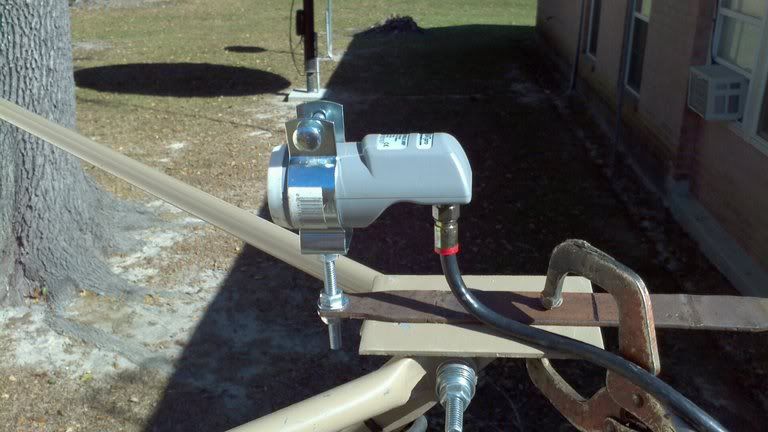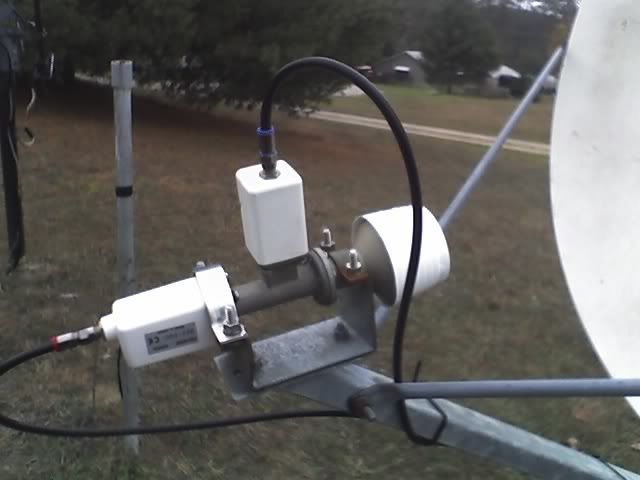I have on my hands an engima that I hope someone can solve. Awhile back I scored a Prodelin 1.8m dish with Dual Ortho feed, Norsat .8 LNB's. At the time folks said they had never seen a 1.8 with the feed setup I had. I took some time, adapted the dish to a polar mount, and got it tracking. Installed the LNB/Feedhorn combo, and off it went. Great signal, great quality. This is the pic of it as installed:

Shortly after, I noticed that the ortho LNB/feedhorn was scanning the Ku frequencies 18mHz HIGH from my other Ku dish, a BV with a quad ortho with Norsat .6 LNB's. I know LNB's shift with age, but 18mHz? No matter what the receiver, no matter what the switch.
So I said well, I have a regular Eagle Aspen linear LNB, that may just bolt up to the horn, I'll try THAT. Somehow the horn was drilled correctly ( couple guys I talked to said theirs wasn't so who knows).... like so:

Same issue. 18mHz high. I changed multiswitches, changed diseqc switches. Ran new coax. Changed the ends. Bypassed the ground block at the dish with barrels. Ran two new coaxes bypassing everything to the multiswitch. No change.
So today, I decided on a test. I had an SatAv Bullet single LNB, went out to the shop, and cobbled up a quick and dirty LNB holder, ran a cable from the LNB to the diseqc switch, scanned a satellite...BAM right on. Scan a satellite with the BV, the bullet was on the same frequency. Scan with the bullet, watch the same freq with the BV.

So the question is....whats causing it? the only thing I can figure is the feedhorn itself, although I don't see how that could be, feedhorn is just aluminum, no electrical connection with anything to affect the frequency. But that is the ONLY constant with the whole situation, its the only thing I didn't change.
My course of action at present is to order a regular dual LNB and fab up a better mount, and just use that. The bullet and the Norsats were dead even quality wise, so I am not worried about signal loss.
What am I missing?

Shortly after, I noticed that the ortho LNB/feedhorn was scanning the Ku frequencies 18mHz HIGH from my other Ku dish, a BV with a quad ortho with Norsat .6 LNB's. I know LNB's shift with age, but 18mHz? No matter what the receiver, no matter what the switch.
So I said well, I have a regular Eagle Aspen linear LNB, that may just bolt up to the horn, I'll try THAT. Somehow the horn was drilled correctly ( couple guys I talked to said theirs wasn't so who knows).... like so:

Same issue. 18mHz high. I changed multiswitches, changed diseqc switches. Ran new coax. Changed the ends. Bypassed the ground block at the dish with barrels. Ran two new coaxes bypassing everything to the multiswitch. No change.
So today, I decided on a test. I had an SatAv Bullet single LNB, went out to the shop, and cobbled up a quick and dirty LNB holder, ran a cable from the LNB to the diseqc switch, scanned a satellite...BAM right on. Scan a satellite with the BV, the bullet was on the same frequency. Scan with the bullet, watch the same freq with the BV.

So the question is....whats causing it? the only thing I can figure is the feedhorn itself, although I don't see how that could be, feedhorn is just aluminum, no electrical connection with anything to affect the frequency. But that is the ONLY constant with the whole situation, its the only thing I didn't change.
My course of action at present is to order a regular dual LNB and fab up a better mount, and just use that. The bullet and the Norsats were dead even quality wise, so I am not worried about signal loss.
What am I missing?




